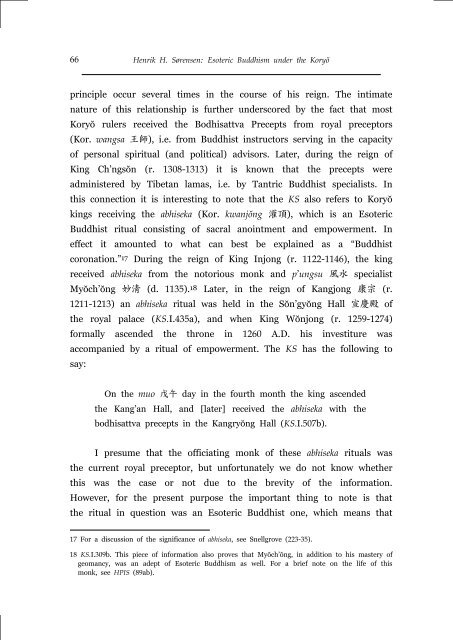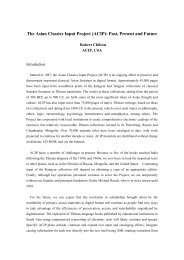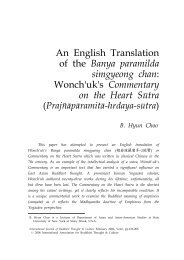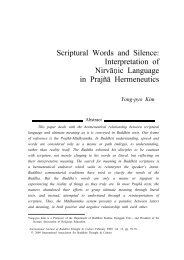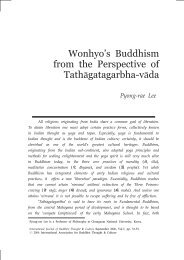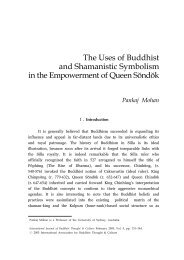Esoteric Buddhism under the KoryÅ in the Light of ... - Buddhism.org
Esoteric Buddhism under the KoryÅ in the Light of ... - Buddhism.org
Esoteric Buddhism under the KoryÅ in the Light of ... - Buddhism.org
Create successful ePaper yourself
Turn your PDF publications into a flip-book with our unique Google optimized e-Paper software.
66<br />
Henrik H. Sørensen: <strong>Esoteric</strong> <strong>Buddhism</strong> <strong>under</strong> <strong>the</strong> Koryŏ<br />
pr<strong>in</strong>ciple occur several times <strong>in</strong> <strong>the</strong> course <strong>of</strong> his reign. The <strong>in</strong>timate<br />
nature <strong>of</strong> this relationship is fur<strong>the</strong>r <strong>under</strong>scored by <strong>the</strong> fact that most<br />
Koryŏ rulers received <strong>the</strong> Bodhisattva Precepts from royal preceptors<br />
(Kor. wangsa 王 師 ), i.e. from Buddhist <strong>in</strong>structors serv<strong>in</strong>g <strong>in</strong> <strong>the</strong> capacity<br />
<strong>of</strong> personal spiritual (and political) advisors. Later, dur<strong>in</strong>g <strong>the</strong> reign <strong>of</strong><br />
K<strong>in</strong>g Ch’ngsŏn (r. 1308-1313) it is known that <strong>the</strong> precepts were<br />
adm<strong>in</strong>istered by Tibetan lamas, i.e. by Tantric Buddhist specialists. In<br />
this connection it is <strong>in</strong>terest<strong>in</strong>g to note that <strong>the</strong> KS also refers to Koryŏ<br />
k<strong>in</strong>gs receiv<strong>in</strong>g <strong>the</strong> abhiseka (Kor. kwanjŏng 灌 頂 ), which is an <strong>Esoteric</strong><br />
Buddhist ritual consist<strong>in</strong>g <strong>of</strong> sacral ano<strong>in</strong>tment and empowerment. In<br />
effect it amounted to what can best be expla<strong>in</strong>ed as a “Buddhist<br />
coronation.” 17 Dur<strong>in</strong>g <strong>the</strong> reign <strong>of</strong> K<strong>in</strong>g Injong (r. 1122-1146), <strong>the</strong> k<strong>in</strong>g<br />
received abhiseka from <strong>the</strong> notorious monk and p’ungsu 風 水 specialist<br />
Myŏch’ŏng 妙 清 (d. 1135). 18 Later, <strong>in</strong> <strong>the</strong> reign <strong>of</strong> Kangjong 康 宗 (r.<br />
1211-1213) an abhiseka ritual was held <strong>in</strong> <strong>the</strong> Sŏn’gyŏng Hall 宣 慶 殿 <strong>of</strong><br />
<strong>the</strong> royal palace (KS.I.435a), and when K<strong>in</strong>g Wŏnjong (r. 1259-1274)<br />
formally ascended <strong>the</strong> throne <strong>in</strong> 1260 A.D. his <strong>in</strong>vestiture was<br />
accompanied by a ritual <strong>of</strong> empowerment. The KS has <strong>the</strong> follow<strong>in</strong>g to<br />
say:<br />
On <strong>the</strong> muo 戊 午 day <strong>in</strong> <strong>the</strong> fourth month <strong>the</strong> k<strong>in</strong>g ascended<br />
<strong>the</strong> Kang’an Hall, and [later] received <strong>the</strong> abhiseka with <strong>the</strong><br />
bodhisattva precepts <strong>in</strong> <strong>the</strong> Kangryŏng Hall (KS.I.507b).<br />
I presume that <strong>the</strong> <strong>of</strong>ficiat<strong>in</strong>g monk <strong>of</strong> <strong>the</strong>se abhiseka rituals was<br />
<strong>the</strong> current royal preceptor, but unfortunately we do not know whe<strong>the</strong>r<br />
this was <strong>the</strong> case or not due to <strong>the</strong> brevity <strong>of</strong> <strong>the</strong> <strong>in</strong>formation.<br />
However, for <strong>the</strong> present purpose <strong>the</strong> important th<strong>in</strong>g to note is that<br />
<strong>the</strong> ritual <strong>in</strong> question was an <strong>Esoteric</strong> Buddhist one, which means that<br />
17 For a discussion <strong>of</strong> <strong>the</strong> significance <strong>of</strong> abhiseka, see Snellgrove (223-35).<br />
18 KS.I.309b. This piece <strong>of</strong> <strong>in</strong>formation also proves that Myŏch’ŏng, <strong>in</strong> addition to his mastery <strong>of</strong><br />
geomancy, was an adept <strong>of</strong> <strong>Esoteric</strong> <strong>Buddhism</strong> as well. For a brief note on <strong>the</strong> life <strong>of</strong> this<br />
monk, see HPIS (89ab).


